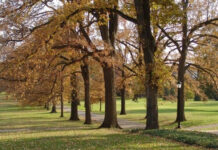As every landscaper knows, factors like humidity, rainfall, and length of seasons determine what to plant and when to plant it. But what do you do when these key elements begin to shift? Changing climate zones and weather conditions are an unfortunate reality for today’s landscapers and their clients. Northern New England currently has a humid continental climate, but, as the northern U.S. warms faster than any other region, the conditions in this zone change year by year. In fact, while Northern New England’s hardiness zones currently range from 3 to 7, they are projected to range from 4 to 8 in 2040; increasing by an entire zone — that’s about 5˚. It may not seem like a lot, but 5˚ can be detrimental to the survival of many plants that previously thrived in New England. Climate change makes it increasingly important to consider plants that can withstand changing weather conditions in any gardening or landscaping work.
Wollaston Development, a Greater Boston-based site development and property design company, has developed a list of climate-smart plants to not only build a long lasting and beautiful landscape, but to support local ecosystems as well. As climate change affects native plant life in New England, plant life in turn affects the native animals who depend on them to survive. While some property owners have turned to non-native plants that fare well in New England’s changing climate, these plants can sometimes hurt local ecosystems by becoming invasive and increasing harmful pests including ticks. As a result, Wollaston Development recommends plants that support local flora and fauna; increasing bird, deer, and pollinator populations throughout the region.
Here are Wollaston Development’s top eight plants to ensure your landscape designs, and New England’s ecosystems, last through climate change:
Tall Grasses
Little Bluestem (Schizachyrium scoparium). This ornamental grass grows in dense bunches about 18″to 24″ tall. The slender stems have a bluish-green hue in the spring, but are most notable for their vibrant mahogany red color in the fall months, which even persists through the winter snow. Little bluestem thrives in hardiness zones 3 to 9, is low maintenance, and deer resistant.

Schizachyrium scoparium. Photo: L. Glasscock, hosted by the USDA-NRCS PLANTS Database/USDA SCS. 1991. Southern wetland flora: Field office guide to plant species. S. Nat. Technical Center, Fort Worth.
- Sideoats Grama (Bouteloua curtipendula). This perennial warm season grass grows in bunches about 2′ to 3′ tall, with leafy, pale green stems at the bottom, and hanging, purple, oat-like spikelets on the top which bloom showy, reddish-orange florets in the summer and bleach to a tan color in the fall. Sideoats grama mixes well in plantings with spring wildflowers due to its short length in the spring. This tall grass thrives in hardiness zones 4 to 9, is low maintenance, and supports bird populations.
Flowering Herbs
- Dense Blazing Star (Liatris spicata). Another showy perennial, the dense blazing star is known for its radiant tall spikes of purple (or sometimes white) flowers that grow 1′ to 5′ tall. The flower clusters have an overall feathery appearance, hence its alternate name, the dense gayfeather. Its linear, grass-like leaves are clumped at the base of the plant, but climb and taper off to the beautiful flowers above. The dense blazing star thrives in hardiness zones 3 to 8, supports both pollinators and birds, and is low maintenance.
- Butterfly Weed (Asclepias tuberosa). As you might infer from the name, butterfly weed is famous for its brilliant butterfly attracting flowers. A lively addition to any garden or yard, this bushy perennial blooms flat-topped clusters of vibrant yellow, orange, or red flowers from early summer to early fall. Its spiraling, lance-shaped leaves are dark-green; creating a beautifully contrasted backdrop for the showy flower heads. Butterfly weed thrives in hardiness zones 3 to 9, supports pollinators, and is deer resistant and low maintenance.

Asclepias tuberosa. Photo: Clarence A. Rechenthin, hosted by the USDA-NRCS PLANTS Database.
Shrubs
- Coastal Sweet Pepperbush (Clethra alnifolia). Also known as summer sweet, this deciduous shrub grows in tall, narrow, mounded clumps about 6′ to 12′ tall. Coastal sweet pepperbush’s leafy branches are spotted with clusters of sweetly fragrant white flowers in the summer. Its oval, toothed leaves turn from their moody, dark-green color to a golden-yellow in the fall. Coastal sweet pepperbush is not only an aesthetically pleasing addition to any yard, but is also incredibly low maintenance since it is resistant to insects and diseases. This shrub thrives in hardiness zones 3 to 9, and supports pollinator and bird populations.
- Ninebark (Physocarpus opulifolius). If you’re looking for a shrub with beauty and incredible adaptability, Ninebark takes the cake. This mound-shaped shrub grows from 3′ to 10′ and blooms charming spherical clusters of white to pinkish flowers from May to June. Adding to its beauty, ninebark also bears vibrant red ornamental fruits in the fall. Ninebark is not only fast-growing, drought-tolerant, and insect and disease resistant, but is adaptable to a wide range of soil and light conditions. Thriving in hardiness zones 2 to 8, its adaptability to harsh conditions makes it perfect for erosion control on banks, but it’s beautiful flowers and fruits may be enough to convince you.

Physocarpus opulifolius.
Trees
- Gray Dogwood (Cornus racemosa). Gray Dogwood is a small, thicket-forming tree that grows up to 16′ in height. Its twigs are an alluring deep red color, and remain so into the late fall and early winter. The twigs produce delicately small white flowers in rounded clusters sometime between May and July, which then blossom into beautiful white, berry-like fruits from August to October which many native birds feed on. Gray dogwood’s red twigs and reddish or purplish Fall foliage make it the perfect plant for a vibrant New England Fall. It thrives in hardiness zones 4 to 8, supports pollinator and bird populations, and is deer resistant and low maintenance.
- Kentucky Coffeetree (Gymnocladus dioica). With its large, blue-green leaves and height of 60′ to 70′, the Kentucky coffeetree is a perfect choice for creating shade in any yard or landscape. In addition to the aesthetically pleasing color of its leaves, this moderately fast-growing tree also bears fragrant white flowers in late spring, which later bloom into reddish brown pods that ripen in October and persist well into winter. The best part? The pods can be roasted and used as a substitute for coffee beans! The Kentucky coffeetree thrives in hardiness zones 3 to 8, and is low maintenance.
Wollaston Development beautifies yards with the environment in mind all over Eastern Massachusetts. From excavation and trucking, to landscape design and commercial masonry, Wollaston Development is dedicated to meeting client needs at all phases.
Want more plant recommendations for better climate resilience? Turf‘s upcoming Winter print edition features a fascinating article by waterwise gardening and xeriscaping expert David Salman, founder and chief horticulturist at High Country Gardens. Don’t miss it! Get your copy here.











![[VIDEO] Dickies®: Discover Workwear That’s Anything But Uniform](https://turfmagazine.com/wp-content/uploads/2023/06/1647663814-4b1a2a7742790a9b1e97a3b963477850192e1d6a9dfba9b07214a77bae25d6e3-d-218x150.jpg)

































![[VIDEO] Dickies®: Discover Workwear That’s Anything But Uniform](https://turfmagazine.com/wp-content/uploads/2023/06/1647663814-4b1a2a7742790a9b1e97a3b963477850192e1d6a9dfba9b07214a77bae25d6e3-d-324x160.jpg)